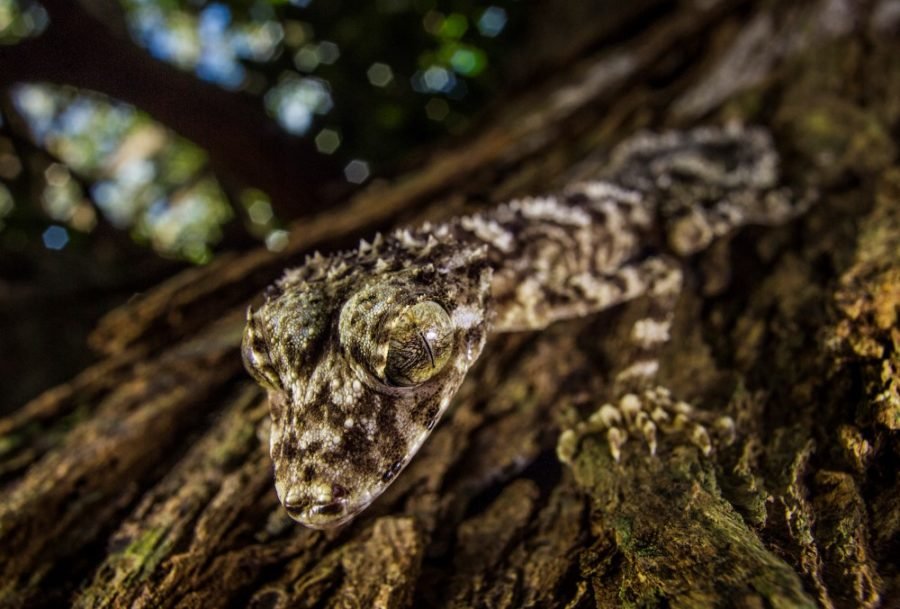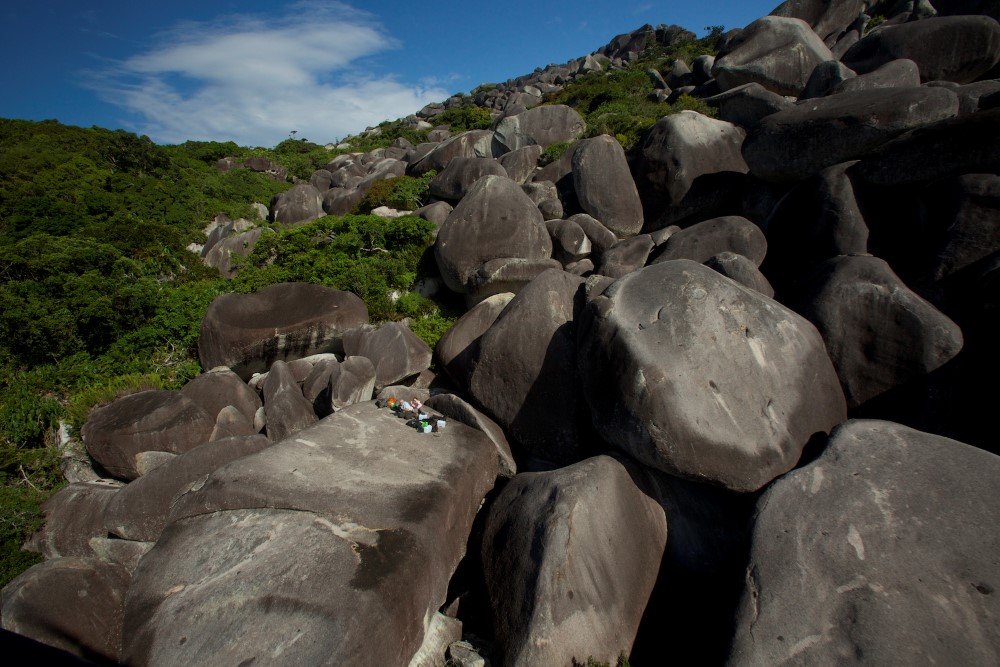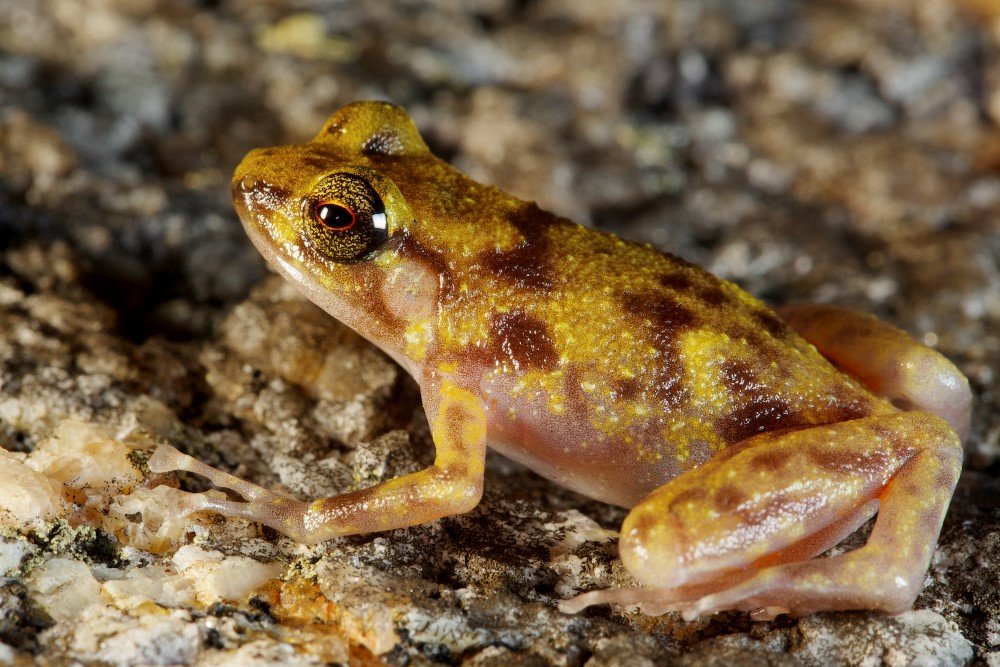Cape Melville’s lost world

DIRECTLY AHEAD WAS a dark mountain of boulders and rainforest rising up from the plains. We’d flown two hours from Cairns – one over the lush rainforest of the Wet Tropics to Cooktown and the other over woodlands and sandstone escarpments as we followed the coast north. Looming in front of us was our destination, Cape Melville – an isolated range barely visited by biologists. We approached in the helicopter to explore the uplands, which had long been a goal of mine.
A decade earlier I’d driven to Cape Melville and stood on the beach looking up at a wall of jumbled boulders, wondering what was at the top. I climbed a fair way, but was knocked back by the heat and the scale of the rocks. I needed a chopper.
Many years later, that wish was fulfilled, but thick cloud stopped us landing in the uplands and instead we explored boulder fields in the lowlands. On the last morning of that trip I was woken at dawn by a brief shower. As the rain eased and the water flowed through the rocks deep into the mountain, I became aware of a strange rattling call. I quickly got up and climbed down among the boulders. After squeezing through crevices, I found a distinctive new species of microhylid frog. Shortly afterwards we departed, having had but a tantalising glimpse into Cape Melville’s secrets.
It looked like a lost world and I was eager to find out what secrets it held.
A couple of months passed before I had the opportunity to return, this time with Dr Tim Laman, a US photographer and ornithologist. As we approached, it became clear that conditions were ideal and I’d finally be able to explore the uplands. Flying over the boulder fields, we could see the top of the range was roughly a plateau, with more upland area and rainforest than expected. There were areas of well-developed forest that seemed to be growing on earth not boulders; I was very excited.
Landing on a giant rock, we swiftly unloaded under the motion and noise of the spinning rotor. As the sound of the departing chopper faded, we stood in the quiet and surveyed the incredible scene. An expanse of forest lay ahead, with hoop pines and black boulders, and wisps of cloud sticking to the highest ridges. It looked like a lost world and I was eager to find out what secrets it held.

Giant boulders dwarf Nancy Donnelly and Mark Lamble, who came along to film a documentary. A helicopter was essential for getting to the uplands. Once there, travel was by foot through the boulder fields – no easy task. (Image: Tim Laman)
Cape Melville is a peninsula dominated by the Melville Range. This sits alone, rising from the plains of drier forests to the south, and bounded on its other sides by the sea. The nearest significant rainforest is 200km south in the ranges of the Wet Tropics or in the McIlwraith Range, 130km north-west on the Cape York Peninsula. Getting there by car from Cairns is an easy drive to Laura and then a long, tough drive through Rinyirru (Lakefield) National Park to Cape Melville National Park, where you finally pop out on the beach at Bathurst Bay – where I’d stood a decade earlier.
Despite its incredible geology, the range remained largely unheard of until 1978 when a local Aboriginal man named Wodyeti told botanists about an unusual palm. The plant was described as the foxtail palm (Wodyetia bifurcata), found only on the boulder fields of Cape Melville, and it caused a stir due to its beauty and the subsequent smuggling of seeds for the nursery trade. The foxtail is now a fixture along esplanades from Cairns to Florida, and has an artificial distribution many times larger than its natural range.
Another plant, the Cape Melville nightshade, was also discovered to be endemic, as well as three vertebrates: the Cape Melville snake-eyed skink, and the Cape Melville tree frog and Cape Melville boulder-frog, discovered in 1998, ’97 and ’98, respectively.
After setting up camp we began exploring. We only had a few days and there was plenty of ground to cover. That afternoon and evening we found interesting species but nothing unexpected. I started to wonder if Cape Melville was too small and too harsh for rainforest creatures to have survived here for hundreds of thousands, if not millions, of years of isolation. After all, the plateau measures just 6 x 3km, and rainforest-dependent creatures that can’t cross gaps in vegetation would have needed rainforest here that entire time. I began to think that perhaps the three known endemics and the new frog was the sum of unique vertebrates, a number of unique species on par with any other mountain in Queensland.

The Cape Melville boulder-frog is one of eight endemic vertebrates. It only emerges from the depths of boulder fields in wet weather. (Image: Tim Laman)
The next morning we woke early and headed higher, onto a ridge. It looked different up here – moister, mossier and rockier. As we walked through an enchanting area of boulders under low rainforest, a small lizard leaping between two boulders caught my eye. There in front of me was an undescribed skink – golden and long-limbed. It was a new species of Saproscincus, a genus of lizards found in rainforests to the south. I subsequently named the species the Cape Melville shade skink (Saproscincus saltus, saltus meaning ‘leaping’). It is the most northerly member of its group and, with its bizarrely long limbs and flattened body, the only one that is adapted to living among the rocks.
This was an exciting start, but only the beginning of what was to be an incredible day of discovery. Shortly afterwards, I caught a large lizard in thick leaf-litter at the base of some boulders and a small, fast skink, which was active on the leaf-litter.
These would ultimately be described as the Cape Melville bar-lipped skink (Glaphyromorphus othelarrni) and the Cape Melville rainbow skink (Carlia wundalthini), respectively. The species names for both were chosen in collaboration with the bubu gudjin, the traditional owners of this land.
By evening we stepped out of the rainforest and onto the boulder fields. The view was magnificent. Behind us were rocky peaks and misty rainforest, and in front of us immense slopes of boulders sweeping down to the ocean. We climbed down into them to search for the new frog I’d found on the previous trip. The rocks were incredibly rough, removing skin with the merest brush against them. And the gaps were treacherous – we regularly found ourselves stepping across chasms that disappeared into the black depths. A wrong move would be serious.
Before too long it was evident that frogs were common here. We found some emerging from deep in the boulders to forage for invertebrates on the surface rocks. I subsequently named this species the blotched boulder-frog (Cophixalus petrophilus, with petrophilus meaning ‘rock-loving’). The species survives the long dry season deep in the boulders where it is cool and moist, and emerges in the wet season to feed and breed near the surface. They are also ‘terrestrial breeders’ – eggs are laid in moist rocks and the clutch is guarded by the male. The tadpoles develop entirely within the eggs, and after a month or so little frogs hatch out and disappear into the depths of the boulder field.
Working our way off the boulders and back into the rainforest, we headed up a gully. Looking ahead I saw red eye-shine coming from a tree growing among boulders. We’d seen plenty of Cooktown ring-tailed geckos (impressive lizards large enough to eat frogs and other geckos), but the way this one appeared to be sitting, head-down and motionless, suggested something much more exciting. I scampered up the boulders and there before me was a creature with long spindly legs, huge eyes and an elaborately frilled tail – a new leaf-tailed gecko!
Although I’d hoped that Cape Melville might harbour such a species, I could hardly believe it was true. The Cape Melville leaf-tailed gecko (Saltuarius eximius, with eximius meaning ‘extraordinary’ or ‘exquisite’) received international fame when it was chosen by the International Institute for Species Exploration in their annual list of the top 10 species discovered globally.
Why are there so many endemic species? And why are they so unusual? The answer to both those questions involves the rock.
These 2013 surveys of Cape Melville revealed five new vertebrate species, a number of range extensions, and some invertebrate and plant species that have yet to be resolved. In terms of vertebrates, the endemic species count went from three to eight, the highest known for any mountain in Australia.
That’s on top of the two known endemic plants and no doubt more species awaiting discovery – and all within an area about the size of Sydney’s city centre. For reptiles and frogs, the species diversity in the rainforest at Cape Melville is not that high. However, it is the distinctiveness of the species here that sets Cape Melville apart. Why are there so many endemic species? And why are they so unusual? The answer to both those questions involves the rock.
The Melville Range is small and not particularly high – about 600m above sea level at its highest – compared with other rainforest refugial areas such as the Wet Tropics, with many mountains more than 1000m. The upland area is important for rainforest persistence because, historically, rainforest contracted to cool, moist peaks during globally dry periods. But what Cape Melville lacks in scale, it makes up for in rock.
The deeply layered rock of the boulder fields would have retained cool, moist conditions through even the toughest times. And they would have kept out fire. Therefore, the massive pile of rocks at Cape Melville acted as ‘lithorefugia’ – cool, moist refuges where rainforest-associated lineages could persist through time. These isolated lineages have split into numerous species over millions of years.
The reason Cape Melville species look so different from relatives in rainforests to the south or north can be attributed to the rock, too. There are some consistently distinctive features among the Cape Melville endemics that are likely to be adaptations to this environment, particularly with respect to movement across and between rocks. The lizards have relatively long limbs and flat bodies, and the frogs are large and have huge hands and finger-pads. Even the unusually large eyes of the leaf-tailed gecko and boulder-frog could be the result of living in the dimly lit crevices.
And what does the future look like for these unique species? Cape Melville NP is now jointly managed by Queensland Parks and Wildlife Service and the Cape Melville, Flinders and Howick Islands Aboriginal Corporation. But despite formal protection and the fortress-like boulder-field slopes surrounding the uplands, there are still threats to this unique environment.
Some invasive species have found their way to the top. Pigs are the most conspicuous example and efforts continue by the park managers to reduce these impacts. Introduced diseases are also a potential threat; on the survey trips we were always very careful that all our clothing and gear was clean and sterilised.
It’s my hope that Cape Melville’s remoteness and ruggedness, along with the management of invasive species, will protect it into the future. In collaboration with the traditional owners of this land, I plan to return here in late 2016 to discover more about the exceptional species that have persisted and evolved over millions of years – so far it’s been a thrilling adventure, and hopefully one that is not over yet.
Dr Conrad Hoskin is a biologist at James Cook University in Townsville, QLD. His research covers evolution, ecology, conservation and species discovery. Some of his studies have focused on diversity in Cape York, and hybridisation in frogs of the Wet Tropics rainforests of north-eastern Australia.
This article was originally published in the May-June 2016 issue of Australian Geographic (AG#132).
RELATED:
- New Cape York species an incredible find
- Cape Melville leaf-tailed gecko in top 10 new species of 2014

